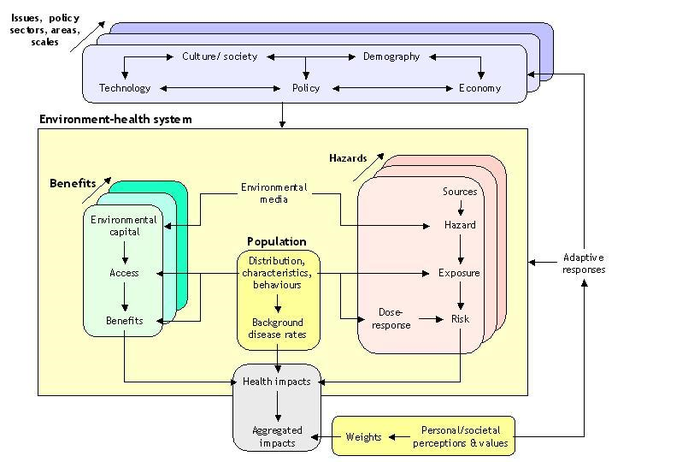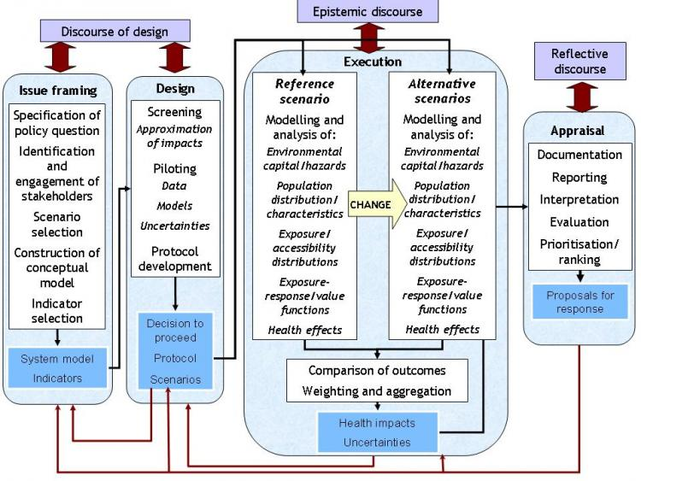Guidance system of the IEHIAS
- The text on this page is taken from an equivalent page of the IEHIAS-project.
Contents
The concept
Integrated environmental health impact assessment provides information on potential environmental influences on public health, in order to help people make better decisions to protect and improve human health. It can be defined as:
Key features of IEHIA are that:
- It is specifically designed to deal with complex issues, which would usually be beyond the scope of more traditional forms of health risk or impact assessment (see links to Other assessment methodologies, left);
- It considers both positive and negative effects on health – i.e. it recognises the environment as both a hazard and a source of beneficial resources (environmental services and capital);
- It attempts to provide a synoptic and balanced measure of impacts, by weighting and summing the various health effects;
- It is designed to be participatory – and thus to involve all the key stakeholders with interests in the issue.
The need for IEHIA
The environment affects human health in many different ways. It operates directly, through the influence of natural hazards such as earthquake and storms. It acts as a conduit for pollutants and other stressors generated by human activities, and a setting within which exposures to such hazards take place. It is also a source of many of the resources that are vital for human life, such as water and food, and thus has major benefits for human healthy and well-being. In almost every case, these environmental hazards and benefits are influenced by human intervention - by policies and technologies. Environment and human action thus interact, often in complex ways, to affect human health.
Assessments are therefore needed to help evaluate and guide these human actions. Integrated assessments are needed because the issues concerned are often complex and interwoven, so that problems have multiple causes, and interventions may have mutliple, and far-reaching effects.
Integrated environmental health impact assessment is therefore aimed at helping decision makers better understand both the environmental factors that affect human health and the consequences of their decisions, so that policies and technologies can better serve human needs.
IEHIA in relation to other assessment methodologies
Integrated environmental health impact assessment does not stand alone. It has developed from (and complements) many other approaches to assessment that have been developed, for somewhat different purposes, over recent decades. These include:
- Risk assessment – which traditionally has focused on the relatively immediate and direct health risks from potentially dangerous substances (e.g chemicals) or practices (e.g. manufacturing processes), often in relation to cancer;
- Comparative risk assessment – which extends traditional forms of risk assessment to the evaluation and comparison of multiple risks (from different sources or agents) across large population groups;
- Health impact assessment – which evaluates the potential health implications of policy or other developments, usually at a relatively local scale (and usually without trying to aggregate the impacts);
- Integrated environmental assessment – which assesses the overall environmental (but rarely human health) impacts of large, complex pressures or developments.
The file (Comparison of assessment methodologies) illustrates the relationship between the first three of these and integrated environmental health impact assessment, and shows how the latter provides an encompassing framework for all these approaches.
References: Briggs, D.J. 2008 A framework for integrated environmental health impact assessment of systemic risks. Environmental Health 7, 61 doi:10.1186/1476-069X-7-61
Hazards and benefits
The environment affects human health both negatively and positively. On the one hand it is the source for, and a setting in which exposures occur to, hazards of many different kinds: physical hazards such as earthquakes, storms, floods, fire or traffic accidents; biological hazards such as vector-borne diseases and pathogens (e.g. malaria, lymes disease, BSE); and chemical hazards, such as pollutants in the air, water or soil. On the other hand, the environment provides most of the basic resources needed for human life (e.g. water and food), as well as many of the amenities which add to our well-being (e.g. places for recreation, relaxation and mental stimulation).
Many of the issues that merit integrated impact assessments involve some combination of these hazards and benefits. Likewise, the vast majority of policies and technologies affecting the environment (whether deliberately or accidentally) have the potential for adverse and beneficial effects. Hazards and benefits are nevertheless different in their expression. They lead to different types of health consequence: hazards typically cause clinically detectable injury or harm; benefits are commonly more subtle in their effect, influencing our socio-psychological state and mental well-being. In many cases, also, they affect different people, in different areas or social groups. Hence, many issues involve both winners and losers.
In doing assessments, therefore, we need to make sure that we have considered and included the benefits as well as the hazards that might arise, and in both cases have properly delineated the populations that might be affected. Otherwise, the assessment will be biased. Considering these very different types of impact, however, also means that we must choose our outcome indicators withspecial care. It is not always sufficient to measure the impacts only in terms of the burden (or absence) of disease. Instead, we need meaures that allow us to sum and compare the negative and beneficial outcomes - for example, monetary measures or indicators of overall well-being.
Steps in IEHIA
The range of questions facing decision makers is large and varied. Integrated environmental health impact assessments thus take many different forms, and often need to be developed and adapted to match the spcific issue being addressed. The issues are also often complex, and touch the lives of a wide range of stakeholders. As a result, many assessments do not proceed in a neat, linear way, but are, instead, somewhat circular and reiterative.
In general terms, however, we can define four key steps in any assessment: issue-framing, design, execution and appraisal.
- Issue framing is done to define clearly what is to be assessed, and who should be involved.
- Design consists of deciding how the asssessment will be done - including the data and methods that will be used.
- Execution is the stage of actually doing the assessment - collecting the data and running the models to determine health impacts.
- Appraisal involves reviewing and interpreting the results of the assessment, and communicating these to the end-users.
These steps (known by their initials as the IDEA framework) provide a valuable struciture within which to organise and run assessments. Following this framework helps to ensure that assessments are targetted as the right issue, are based on good scientific principles. NOte also that stakeholders should be involved (in different types of discource) at every stage, in order to make sure that the assessment is acceptable to the people concerned, and thus that it can provide a sound basis for effective decisions.
Issue framing
Issue framing represents the first stage in doing an integrated environmental health impact assessment. It is at this stage that we specify clearly what question we are trying to address, and who should be involved in the assessment.
For more information, see the Issue framing in the IEHIAS main page.
Design
The Design stage in an integrated environmental health impact assessment takes forward the 'conceptual model' of the issue, defined during issue framing, and converts it into a detailed protocol for assessment.
For more information, see the Design in the IEHIAS main page.
Execution
The execution stage is the heart of the assessment process; it is the point at which the full analysis is carried out and the results obtained.
For more information, see the Execution in the IEHIAS main page.
Appraisal
The purpose of appraisal is to bring together, communicate and interpret the results of the assessment as an input to this dialogue.
For more information, see the Appraisal in the IEHIAS main page.


